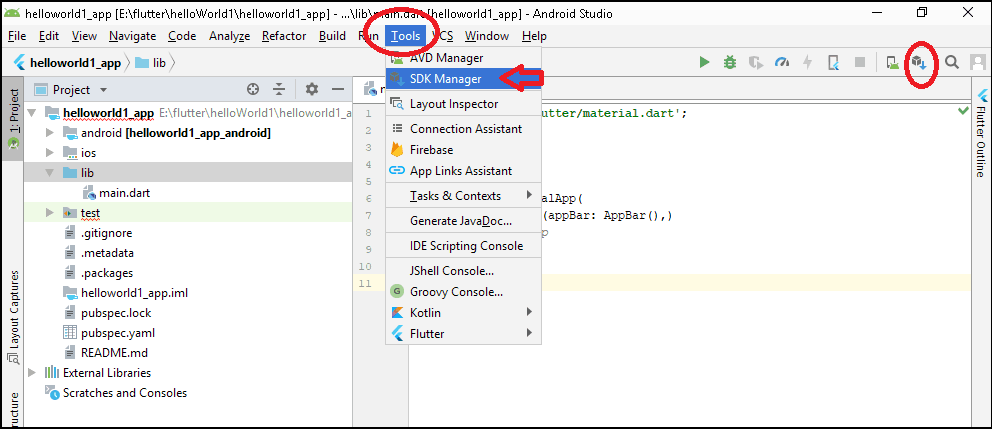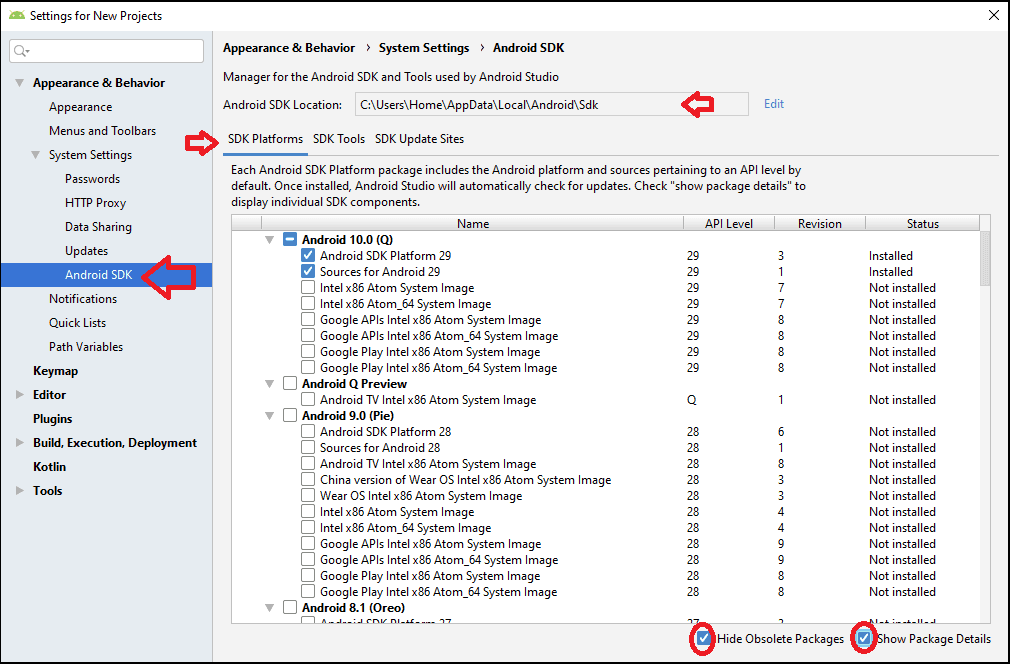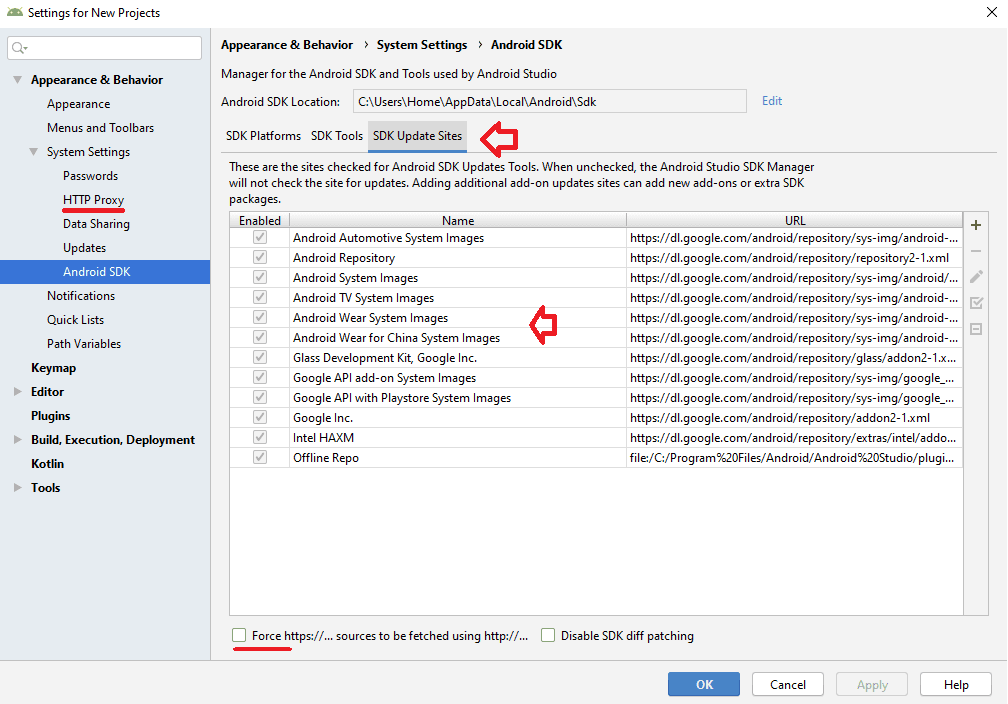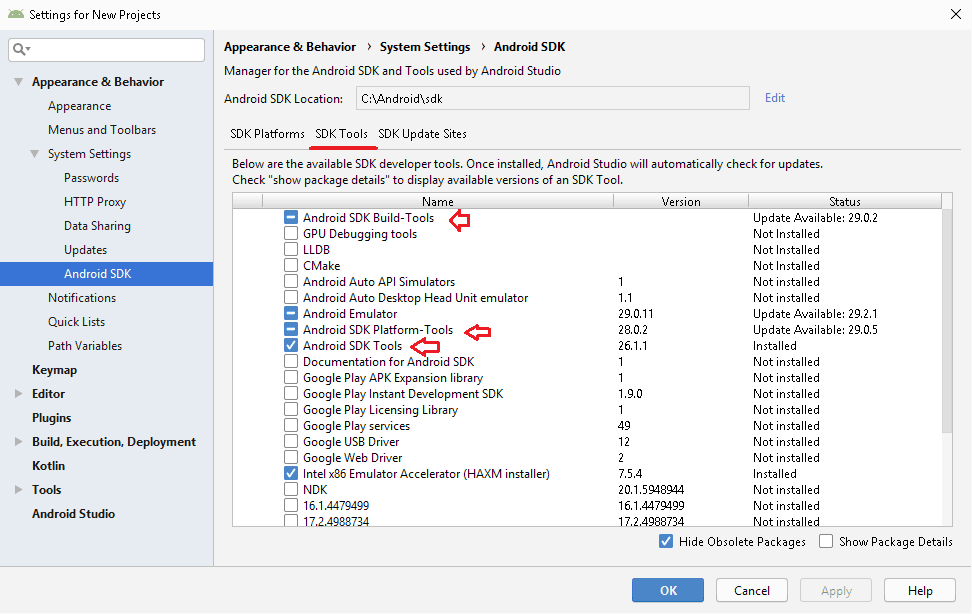- AVD Manager & SDK Manager Missing or greyed out in Android Studio
- AVD Manager is missing
- SDK Build Tools are not installed
- SDK Path is Invalid
- Android SDK Manager not visible
- References
- Summary
- How to Install Android SDK Tools
- What is Android SDK
- Android SDK Manager
- Android SDK Location
- SDK Platforms
- SDK Tools
- SDK Update Sites
- How to install the Android SDK
- Summary
- Android studio – отсутствует каталог инструментов SDK «
AVD Manager & SDK Manager Missing or greyed out in Android Studio
AVD Manager or SDK Manager becomes greyed out or goes missing from the Android Studio is the common issue that arises in Android studio. This guide explores all the possibilities of that happenings and discusses how you can solve them.
You can find the AVD Manager & SDK Manager option under the Tools menu as shown below. In the older version of the Android studio you will find this menu under the Tools -> Android.
It may happen that you may find AVD Manager & SDK Manager options goes missing from the menu as shown below
Table of Contents
AVD Manager is missing
- Android Menu under tools is missing.
- Might see “Failed to find Build Tools revision xx.x.x” as shown below
- AVD Manager is greyed out in the toolbar
This may happen for several reasons
- SDK Build Tools are not installed
- Invalid SDK Path
SDK Build Tools are not installed
SDK Build tools are installed when you create a new project. If it fails then you may have to install it again. You look at the build tab at the bottom of the screen, it will display the error message and option to install the Build tools. Install it and you should be able to see the AVD Manager.
Another way is to go to the SDK Manager. Under SDK Tools you will find the Android SDK Build tools. Install based on the API. Also ensure that you have the latest version of Emulator, Platform-Tools & SDK Tools installed.
SDK Path is Invalid
Invalid or Missing SDK Path is another reason for such errors. Open the Android SDK Manager ( Tools -> SDK Manager) and check the Android SDK Location as shown in the image below

Ensure that it points to the correct location. The SDK is usually installed at the location C:\Users\ \AppData\Local\Android\sdk . If you cannot find the location or you have logged in as a different user, then you can create the folder and enter it here. Once the path is valid, the Android studio will download & install the required SDK on its own.
Android SDK Manager not visible
If Android SDK Manager is not visible then you need to reinstall the Android Studio. Follow these steps to Uninstall and Install Android Studio.
- Uninstall Android Studio
- Delete the folder C:\Program Files\Android ( C:\Program Files (x86)\Android if 32bit installation)
- Remove the SDK Folder. You will find it here C:\Users\ \AppData\Local\Android\sdk. (unless you have changed it)
- Install the Android Studio
References
Summary
In this guide, we learned how to solve the AVD Manager or SDK Manager missing or greyed out issue in Android Studio.
Источник
How to Install Android SDK Tools
To Develop Android-based Apps, you will need to Install Android SDK. In this How to Install Android SDK Tools, we will learn what is Android SDK is and how to install the Android SDK using Android Studio. First, we will learn about the Android SDK Manager GUI to manage the SDK. We will find out how to find out the SDK location, various components of SDK like SDK Platforms, SDK Tools, Build Tools, Platform-tools, System Images, Emulators, etc. Finally, we will show you how to install the Android SDK.
Table of Contents
What is Android SDK
The Android Software Development Kit (SDK) is a set of development tools, which is needed to develop Android-based applications.
We can create Android Apps in many ways. You can make use of Java or Kotlin or use frameworks like Ionic, NativeScript or React Native. But whichever tools you use the Android SDK is a must.
The Android SDK comes with the required tools to build Android apps. Using the SDK you can install the app in the device and access the features provided by the OS. The SDK also comes with tools to debug the application. The Android emulator allows you to test apps in different types of devices, without needing to buy one.
The Android SDK comes in various versions. Each new release of Android OS is accompanied by a new SDK version or API Version. For Example, the latest Android Pie ( or Android 9 ) has a corresponding SDK API version of 28. You can refer to the SDK Platform release notes to find out the more details about each release
Android SDK Manager
The Android SDK Manager helps us download & manage the Android SDK. It makes it very easier to search for updates, install and remove the older unused SDK’s easily
The SDK Manager is part of the Android Studio and installed along with it. Hence, you need to install it first. Refer to our tutorial How to download & install the Android Studio tutorial.
You can open the SDK Manager by clicking on Menu Option Tools -> SDK Manager ( or Tools -> Android -> SDK Manager in older versions of Android Studio). You can also click on the 

The Following is the image of the Android SDK Manager

In the lefthand side pane, you have to select Android SDK under Appearance & behavior -> System Settings
Android SDK Location
The Android SDK path is usually C:\Users\ \AppData\Local\Android\sdk as shown in the image above. But you can change it by clicking on the edit link.
The SDK Location is very important if you are using NativeScript or ionic, For NativeScript to pick up the SDK you need to define the ANDROID_HOME environment variable. While the ionic expects ANDROID_SDK_ROOT environment variable to point to the SDK path.
The SDK Manager contains three tabs. They are SDK Platforms SDK Tools & SDK Update Sites.
SDK Platforms
This tab contains the list of Android SDKs. The SDKs are a must if you want to develop apps targeting the Android Platform. Each new version of Android comes with its own SDK version ( API level and a revision).
Under each API, there are a few different types of files, which are displayed only if you select show package details option. They are shown in the image below.
Android SDK Platform:
This file is required to compile and run the Android Application. At least one SDK Platform must be installed. Always use the latest SDK version, when developing the App. You are still able to run the App on the older versions of Android.
Sources for Android package:
The source files for the platform, contain metadata about the SDK Platform and is helpful when debugging the android App. Always install the corresponding sources when installing the SDK Platform
System Image packages:
These are used by the Android Emulators to run the App in Emulator. Each SDK platform version contains a list of supported system images. You must select an image based on your computer Processor. You can also install them when you are creating the Android Virtual Devices (AVDs) using the AVD Manager.
SDK Tools
This tab contains the set of development and debugging tools for the Android SDK
Android SDK Build-Tools: Required
This contains the tools required to build Android Apps. You must install this package. See the Android SDK Build tools release notes.
Android SDK Platform-Tools: Required
This contains the tools required by the Android platform. The tools like ADB (Android Debug Bridge) are part of the Platform-tools. This package is required. See the Android SDK Platform Release notes
Android SDK Tools: Required
This tool includes essential tools such as ProGuard etc. See the SDK Tools Release Notes.
Android Emulator: Recommended
The Android Emulator was part of the Android SDK Tools up to version 25.2. Now they are available to install separately. You need an Emulator to debug and test your applications in an Emulated Android Runtime. See the Android Emulator release notes.
SDK Update Sites
This tab lists the Android & third party sites, where Android Studio looks for the update. You can add other sites to the list and download the packages from those sites as well.

If you are behind a proxy server, then remember to setup the proxy server from the HTTP Proxy option.
How to install the Android SDK
To Install a new SDK click the checkbox, Similarly to update an SDK. Whenever an update is available a dash appears in the checkbox next to the package. The status field shows the current installation status of the SDK.
To remove or uninstall a package, unselect the checkbox
Click on the Apply or OK button to begin the installation.
Next, you may be asked to accept the License Terms and then the installation begins. Installation takes some time to complete depending on the no of packages you have selected.
Once done, click on Finish. Now the Android SDK is successfully installed.
Summary
In this How to Install Android SDK Tutorial, we learned what is Android SDK is and how to install/update it using Android SDK, We also learned a few things about SDK Platform, SDK Tools, SDK Platform build tools, SDK Build Tools, System Images, etc.
Источник
Android studio – отсутствует каталог инструментов SDK «
Когда я запускаю программу «android studio» , отобразилось окно «downloading components» котором говорится: «Android SDK was installed to: C: / Users / user / AppData / Local / android / SDK2 SDK tools directory is missing » Я могу Не исправить, и мне нужна помощь!
«Android SDK был установлен на: C: / Users / user / AppData / Local / android / SDK2 SDK tools отсутствует» Это означает, что для Android SDK требуется папка «tools» , где был установлен этот SDK. Но эта папка «Инструменты» не установлена. Вероятно, из-за низкого объема хранения.
[РЕШЕНИЕ] : Удалите Android SDK и установите его снова. На этот раз просто убедитесь, что у вас есть ATLEAST 5GB (хотя на 3.2gb будет достаточно) свободного места, где вы собираетесь установить этот SDK. Как только установка будет завершена, просто проверьте, есть ли папка «инструменты» (в месте, где вы устанавливаете SDK)
Просто сделайте следующее, и все будет хорошо.
- Когда появляется ошибка, а не щелчок на «финише», нажмите «x». Он попросит вас инициализировать. Возьмите рекомендованный вариант.
- После его реконфигурации он вернется к главному экрану. Просто перейдите к
Configure -> Project Defaults -> Структура проекта и скопировать вставку или просмотр (папка appData может быть скрыта) в местоположение C: / Users / user / AppData / Local / android / SDK. - Завершите и снова попробуйте создать проект. Будет работать как очарование !! 😉
Если ваш каталог инструментов SDK отсутствует, возможно, вы случайно удалили его, и есть простой способ загрузить его и направить на него студию Android.
Сначала перейдите на сайт разработчика android ( https://developer.android.com/studio/index.html ), прокрутите страницу до конца и выберите свою загрузку в соответствии с вашей системой (но не загружайте версию установщика для окон ) Вам нужен zip-файл, содержащий SDK.
После загрузки просто поместите его в мои документы (MAC или WINDOWS), а затем, когда вы откроете экран студии Android, вы увидите всплывающее окно для установки SDK (например, время, когда у вас возникла ошибка), не нажимайте кнопку «Далее», переходите к просмотру, найдите этот файл И нажмите ОК. После этого идите дальше, и это будет работать как шарм.
Это было проблемой для меня, потому что у меня уже был SDK, установленный в другом каталоге. Чтобы сообщить Android Studio, где вам требуется SDK, вам нужно перейти к настройкам, но диалог «Каталог инструментов SDK отсутствует» всегда выводит всю программу, когда вы нажимаете «Готово». Вот как я «решил» это:
- Удалите свои папки
/.Android* (потеряв все ваши настройки: /).
Удаление папок .Android Studio может быть ненужным – я никогда не пытался нажимать X в исходном диалоговом окне ошибки – я только пытался «Готово», который выходит из Android Studio. Это возможно, если вы нажмете X, вы можете перейти к настройкам, но, к сожалению, я не могу вернуться и проверить.
У меня была эта проблема, когда я пытался переустановить Android Studio с помощью своего мастера. У меня уже была папка «tools».
В моем случае, в то время как каталог «tools» уже существует, он также предоставит ошибку «sdk tools directory» для своих подпапок. Как-то у моей папки sdk был только подкаталог libs.
Когда я вставлял в sdk / ant, sdk / apps, sdk / proguard, sdk / qemu, sdk / support и sdk / templates, мастер наконец был доволен этой конфигурацией и пошел загружать еще несколько файлов.
Попробуйте установить его в другом месте, возможно, это решит проблему. Кроме того, вы можете попробовать установить его на USB-накопитель.
Измените каталог SDK на C: \ Users \ username \ AppData \ Local \ Android \ Sdk
Если вы используете новейшую студию Android, вы можете настроить ее, используя Configure -> Project Defaults -> Project Structure
В моем случае это была установка в уже существующий каталог. Когда вы выбираете каталог для установки. Программа не позволит вам вводить несуществующий каталог. Поэтому выберите путь, вернитесь в главное окно и введите новое имя папки, где вы хотите установить SDK, возможно, функцию.
Я испытал эту ошибку, когда устанавливал Android Studio со слишком маленькой памятью, чтобы установить все необходимое. Это не помогло освободить память или установить Android SDK. Переустановив студию Android с достаточной памятью, начался запуск загрузки, когда я впервые открыл Android Studio.
Когда вы сначала устанавливаете студию android и все, установите sdk в новый файл, например C: \ Android \ sdk, и убедитесь, что все следующие параметры установки sdk указывают на папку, в которую вы установили sdk. Теперь он будет работать нормально … он должен иметь какое-то отношение к разрешениям в папке appdata, это то, что моя догадка
Я также столкнулся с той же проблемой, проблема со мной была в моем первом запуске, я не был подключен к Интернету должным образом. После подключения к Интернету потребовались некоторые обновления для загрузки, а затем он работал без каких-либо проблем
Ваша папка AppData скрыта, вы должны открыть ее
Источник




